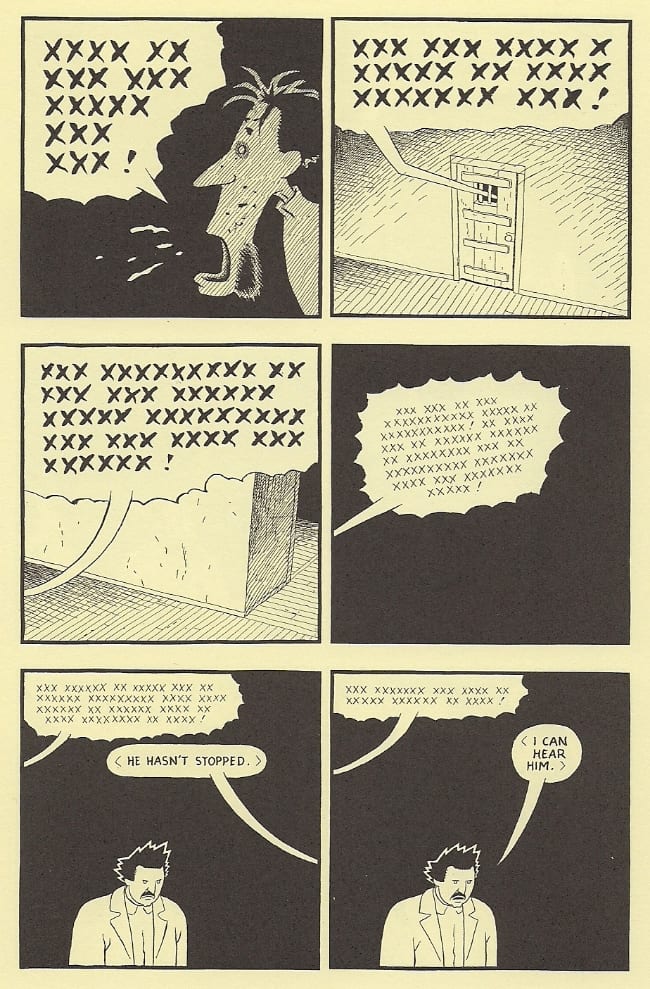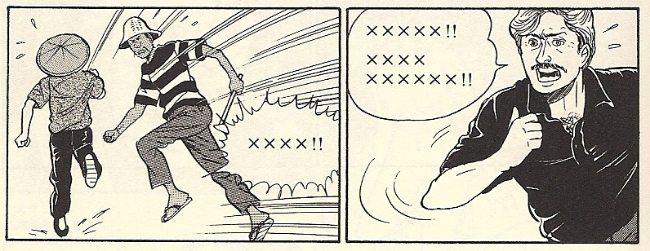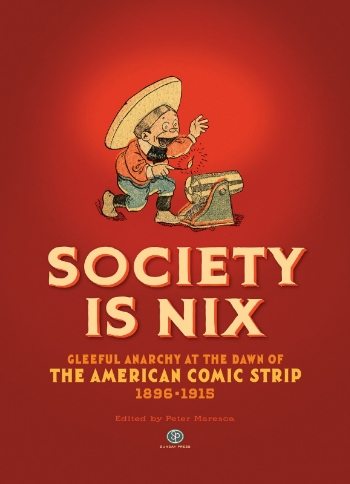Just a small digression this week, as I've gotten myself preoccupied by pre-convention activities. Did you know there's a comics show this weekend in Maryland? The rumors are true! And while Chester Brown does not appear to be a special guest this year, I suspect Drawn & Quarterly will have copies of the new 10th anniversary edition of Louis Riel available; I have excerpted a portion of my favorite bit above.
Regarding all the XXXXXes, it is noted on-page that the marks represent "racist comments and profanity," which I understand Brown deployed to prevent the reader from deriving humor or admiration from the actual content of the language. Basically (and to excerpt a bit from such intent), it is a means of indicating the presence of racism, as divorced from the racist signal. An elegant solution, I think, and rather unique; you could imagine my surprise, then, at discovering another example of much the same technique in a very different context:
God help us, we're back to Shima Kōsaku, one of this column's preoccupations, which I'd really thought I'd gotten out of my system. Unfortunately, I couldn't help but notice this segment from a late '90s storyline, in which a sleazy American guy (w' American sleaze mustache) abuses Vietnamese farmers, much to the controlled dismay of (then-Division Chief) Shima.
Creator Kenshi Hirokane's intent is less clear than Brown's. While it could be that the American man is hurling profane language at the farmers, it's also just as likely that he's speaking in such fast and furious English that Shima -- the point of view character -- can no longer follow his speech. Truth be told, I have no idea as to what sort of restrictions on language might be place for a seinen manga either; perhaps this was an editorial suggestion, although Hirokane has nonetheless been known to play cute with such necessities. I recall a sex scene from somewhat early in the series where the obligatory genital-covering mosaic expanded to render the entire bedroom scene incomprehensible, no doubt teasing the reader over the possibility of staring at a gigantic splash of Shima's prick. Once obscenity concerns were relaxed to the point where female pubic hair was allowed, Hirokane's studio then simply stopped depicting male frontal nudity altogether, so as to eliminate the necessity of such intrusive effects.
It is, of course, highly unlikely that Brown saw this XXXX technique at play in Hirokane's work, though it only preceded the beginning of the Louis Riel serialization by a few years. Perhaps an idea was just in the wind? Or is there a prior usage, which I simply can't remember? Comics is redolent with funny $@%!, but such self-conscious, purposeful obscure stuff seems a little more unique, regardless of provincial traditions.
***
PLEASE NOTE: What follows is not a series of capsule reviews but an annotated selection of items listed by Diamond Comic Distributors for release to comic book retailers in North America on the particular Wednesday, or, in the event of a holiday or occurrence necessitating the close of UPS in a manner that would impact deliveries, Thursday, identified in the column title above. Not every listed item will necessarily arrive at every comic book retailer, in that some items may be delayed and ordered quantities will vary. I have in all likelihood not read any of the comics listed below, in that they are not yet released as of the writing of this column, nor will I necessarily read or purchase every item identified; THIS WEEK IN COMICS! reflects only what I find to be potentially interesting.
***
SPOTLIGHT PICKS!
Boxers & Saints: Ever since American Born Chinese exploded in 2006 as a crucial early hit for First Second, providing not only financial success for the line, but a certain amount of critical cachet in the wider book world -- particularly unique given the work's applicability to the growing 'YA' market, thus positioning the project as perhaps something of a guiding light for the line's eventual demographic focus -- writer/artist Gene Luen Yang has occupied a special place of renown with the publisher, no doubt facilitating what First Second is now deeming one of its most ambitious undertakings. Comprised of two softcover volumes in a slipcase (512 pages in sum), Boxers & Saints serves as a sort of dialectic graphic novel, with each segment embodying the perspective of one of two protagonists, against the backdrop of the Boxer Rebellion: a boy who comes to see the presence of Christian missionaries as an imperialist incursion, and a girl who finds in them a vision of a more equitable future. Call it 'literary YA' if you want, or maybe just 'mainstream comics,' per the same stream which carried Building Stories aloft. Note that each of the volumes will also be available separately, under the titles Boxers and Saints; $34.99.
Society is Nix: Gleeful Anarchy at the Dawn of the American Comic Strip 1895-1915: One of the most striking reprint projects of 2011 was Sunday Press Books' Forgotten Fantasy: Sunday Comics 1900-1915, a sampler of short-run newspaper projects, presented with an eye towards the sort of maximal visual appeal generally compromised by reprint efforts, yet utterly integral to the impact of such works upon audiences of the day. And while this does not appear to be an *actual* sequel to that weighty tome, it is similarly 156 pages, similarly 16" x 21", and similarly dedicated to exploring the nooks and crannies of early, wildly diverse American comics, albeit now in a buckshot style firing out contributions by over 50 artists, ranging from confirmed masters (Winsor McCay, George Herriman) to the ultra-obscure, with pages unseen in print for over 100 years. Edited by Peter Maresca, with supplemental articles by Thierry Smolderen, R.C. Harvey, Brian Walker, Bill Kartalopoulos, Paul Tumey and others. Samples; $125.00.
--
PLUS!
The Best of Milligan & McCarthy: In which Dark Horse presents 264 pages in a 7.75" x 11" hardcover, comprising "the best" of collaborations between writer Peter Milligan and artist/writer Brendan McCarthy. Everyone who's probably super-interested in this stuff has, in all likelihood, already tracked it all down, but still, for the benefit of the next generation or curious onlookers: Rogan Gosh is, to my mind, the best thing a 2000 AD-related magazine ever published, and Paradax is among the most precognitive superhero comics of the pre-Watchmen 1980s. Also included are the early Direct Market psychedelic classic Freakwave, the notorious, Carol Swain-colored Skin (an unholy fusion of Crisis-borne social awareness and Taboo-worthy grotesque horror, with autobiographical touches) and Sooner or Later, from the pages of 2kAD itself. Plus, assorted bonuses, which may well draw from the duo's origins in the late '70s UK music newspaper/post-underground comics scene(s). Samples; $24.99.
Low Society: I was not expecting to see a new Aardvark-Vanaheim comic book on the list today (EDIT: probably because it's from a totally different publisher, Comic Lab Press), but apparently Dave Sim is (not) publishing this record of an early 2013 effort by the Toronto Comics Workshop's Comics Lab, in which aspiring cartoonists work with editor Rob Walton in a simulated professional environment - here, specifically, on new stories involving the parodic characters of Cerebus. Basically, it's an official tribute book, hearkening back to the proverbial "early, funny ones," with a cover boasting new backgrounds by Gerhard(!) and character inks by Sim himself; $4.99.
Little Tommy Lost: A potential middle ground between the last two entries, I think, as Koyama Press is perfectly Canadian, and artist Cole Closser is here working in a simulated early newspaper comic style -- complete with dailies, Sundays, and 'faded' source materials -- in his depiction of a young boy separated from his family on a trip to the big city. A 10" x 7.5" landscape-format softcover, with 72 color pages. Samples; $15.00.
Little Fish: A Memoir: While I can't say I know much about Philadelphia-based artist Ramsey Beyer, my patriotism as a Pennsylvanian commands some acknowledgement of a new 272-page mixed-media-ish autobio comic from a YA/teen-focused publisher I've never heard of (San Francisco's Zest Books), releasing what appears to be their first-ever comic. Samples; $15.99.
The Summit of the Gods Vol. 4 (of 5): Slowly but surely, Fanfare/Ponent Mon creeps up on the climax to one of their outstanding Jiro Taniguchi series, this one a 2000-03 collaboration with writer Baku Yumemakura, on the manly struggle of mountain climbing. I say 'manly' because Summit of the Gods was serialized in Business Jump, a seinen magazine aimed at providing escapist fare for twentysomething-and-up salarymen; if you've ever seen the film Story of Ricky, for example, the source material for that was also a Business Jump manga. However, because seinen manga have a difficult time on the North American market, it's made more sense to characterize it as a 'Jiro Taniguchi' project, thus placing it (and the similarly poppy likes of The Quest for the Missing Girl) in parity with more subdued and reflective works a la The Walking Man and A Zoo in Winter, to say nothing of The Times of Botchan (which is rather in a class all its own). Your manga pick of the week, weighing in at 312 pages. Preview; $25.00.
Blade of the Immortal Vol. 27: Mist on the Spider's Web: Of course, back in '96 when this Dark Horse translation started, it was *assumed* that seinen manga would prove eminently marketable, since women and kids didn't particularly like comics anyway. WHOOPS! That said, Hiroaki Samura's bloodbath dramatics have proven resilient indeed, and there shouldn't be anything but waiting in the path of the publisher's English completion of this now-concluded series. Preview; $19.99.
Crusade Vol. 1 (of 4): Simoun Dja & Wayne Shelton Vol. 1: The Mission: Turning our attention to Europe, it looks like Cinebook as a new slew of French translations ready, and these are the series debuts of the bunch. Crusade is a 2007-09 historical supernatural adventure project from writer Jean Dufaux and artist Philippe Xavier, the latter of whom drew a bunch of North American indie genre comics in the '90s and early '00s, like LegendLore at Caliber and Mortal Souls at Avatar. Wayne Shelton, meanwhile, is an awesome-looking ongoing international troubleshooter project from XIII co-creator Jean Van Hamme and artist Christian Denayer. NOTHING SAYS EXCITEMENT LIKE "WAYNE SHELTON"; $13.95 (each).
Sláine: Time Killer & Sláine: The King: This year marks the 30th anniversary of the Pat Mills/Angela Kincaid barbarian creation for 2000 AD, and, to mark that occasion, Mills is presently serializing a special anniversary storyline reuniting him with various notable artists from throughout the strip's history. It's all been rather DC Comics so far -- continuity-minded callbacks to favorite past scenarios with little in the manner of compelling narrative propulsion, I mean -- but last week's big Simon Bisley chapter adopted a curiously contemplative stance; it was Mills' & Bisley's The Horned God which sealed the strip's renown through its great success as a deluxe collected edition, and so the new Mills/Bisley story has Ukko (the title character's sidekick and biographer) angst over the potential financial benefits of releasing Sláine stories in accumulating permanent (and costly) editions, as the Celtic oral traditions from which the series is drawn suggest a period when access to culture did not require such upfront costs. A metaphor for digital distribution, I suspect, though many will nonetheless want these print editions of early content (1984-85 and 1985-88), with new covers for the special year. Art by Massimo Belardinelli, Glenn Fabry, Bryan Talbot and others; $21.99 & $24.99 (respectively).
Mars Attacks Judge Dredd #1 (of 4): What Sláine hasn't accomplished through his conquests, however, is a totally separate continuity with a North American publisher, which Judge Dredd presently enjoys with IDW. It's from this timeline -- which essentially means you can disregard 2000 AD chronology to draw whatever you want from whenever you want -- that Dredd veteran Al Ewing brings Mega-City One into conflict with a fully licensed Martian invasion, a la several other Mars Attacks! series drawn by John McCrea, also the artist here, and himself a longtime British comics expert. Note that Ewing is also beginning a new series at Marvel this week, Mighty Avengers, with art by Greg Land & Jay Leisten. Preview; $3.99.
Locke & Key Alpha #1 (of 2): Also from IDW comes the penultimate issue of what is probably the most prominent of the publisher's original concepts since 30 Days of Night, a supernatural-tinged youth adventure series from writer Joe Hill and artist Gabriel Rodriguez. What little of it I've read seems accomplished and sturdy, and I expect it will enjoy a significant afterlife in successive bookshelf reissues. Note that the Alpha miniseries will have 32 pages of story content per issue, hence the increased price. Preview; $7.99.
SpongeBob Comics #24: Hard to believe how many of these United Plankton licensed comics are out there already, usually with some pretty interesting artists involved. The SpongeBob affection for Air Pirates Funnies veteran Gary Hallgren is a special delight, and he returns for new contributions to this issue, along with indie comics vet Graham Annable and others; $2.99.
Prophet #39: Meanwhile, though this Brandon Graham-fronted revival of an old Rob Liefeld concept continued its own numbering from the original '90s series, this is nonetheless the 19th issue, which is quite an accomplishment in today's serial comic book scene. And because one the more amusing traits of the series is its presentation of far future versions of other Rob Liefeld characters, it's worth noting this special issue focusing on the Youngblood character Diehard, with art by a slew of guests including James Stokoe, Malachi Ward, Ron Wimberly and others, along with series regulars Simon Roy, Giannis Milonogiannis, Joseph Bergin III and Graham himself. Preview; $3.99.
Louis Riel: A Comic Strip Biography: As mentioned above, this is a 10th anniversary softcover printing of the Chester Brown biographical classic, now 296 pages with a new introduction and a cover gallery of serialized issues. Preview; $21.95.
RASL: And finally, also in updates -- and SPX, for that matter, where Jeff Smith will be present and accounted for -- Cartoon Books brings a new 472-page hardcover compilation of the artist's desert-blasted sci-fi series, now fully colored by Steve Hamaker. I always felt the airiness of Smith's b&w art gave it all a distinct visual identity from Bone, but the earlier project does undeniably stand as a testament to the potentially revitalizing quality of colorization. Samples; $39.95.
--
And on that note, be aware that I will be running a panel at SPX this weekend: "Paying Tribute: Traditions of Style," with Ed Piskor, Jim Rugg, Tom Scioli, Seth and R. Sikoryak all in attendance, unless one or more of them do(es) not attend. It's on Sunday at 4:00 PM. Feel free to come up afterwards and ask me to summarize all your favorite comics in one paragraph or less, at which point I will run away.
--
CONFLICT OF INTEREST RESERVOIR: Several continuing series in hardcover this week, including the translated likes of Wandering Son Vol. 5, the latest from artist Shimura Takako's world of gendered angst, as the characters prepare to enter junior high; $24.99. Then we ride off toward the American public domain with Heroic Tales: The Bill Everett Archives Vol. 2, another 248 Blake Bell-edited pages of Red Reed and Skyrocket Steele and all the rest; $39.99. And then we can just disregard story entirely to bask in the glow of Love and Rockets: The Covers, a 10.25" x 13.25" showcase for just that; $35.00.










